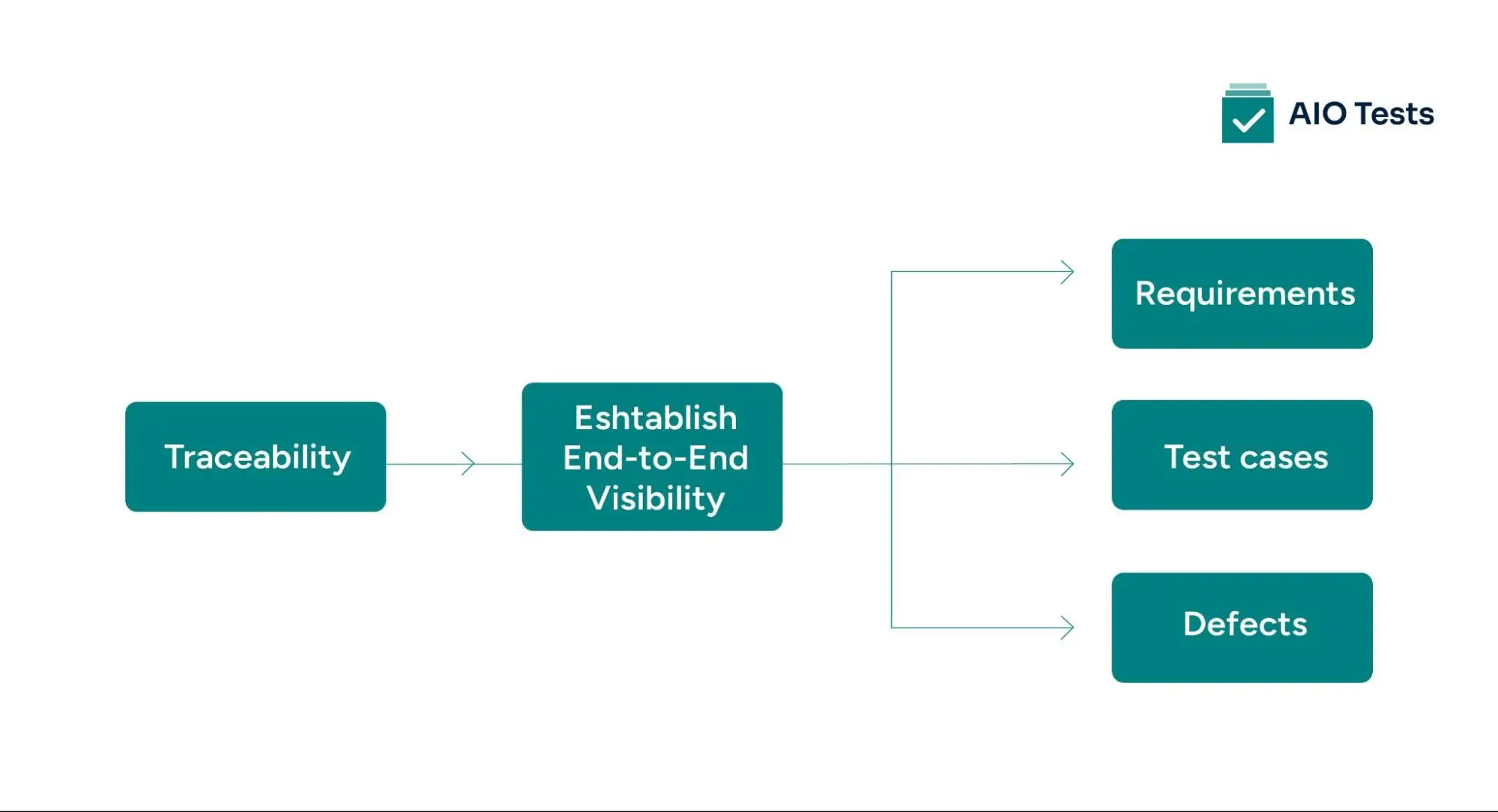Quick Summary
Learn how the Jira software testing tool helps QA teams improve traceability, link requirements, and manage test coverage from start to release.
Many QA issues don’t come from the test cases themselves but from the inability to trace those test cases back to their original requirements, user stories, or defects. Without clear traceability, teams are left guessing what’s tested and what could break next.
This gap creates confusion during releases, delays root-cause analysis, and increases the risk of overlooking critical bugs. With various types of software testing, from functional to regression to exploratory, being executed across teams, the testing process becomes harder to manage and scale with confidence.
While Jira doesn’t offer native traceability features out of the box, it becomes a powerful engine for connected QA workflows when integrated with the right test management tools. These plugins enable teams to link requirements, test cases, executions, and defects within Jira.
In this blog, you’ll learn:
- Why QA traceability is key to better software quality
- How Jira enables connected, test-driven workflows
- Best practices to use its traceability features effectively
- And how to get started with a structure that supports better testing outcomes
What Is Traceability In Jira?
In testing workflows, traceability means being able to track every requirement from start to finish across test cases, executions, defects, and deployments. It helps QA teams ensure that every business objective has been tested, every defect is accounted for, and every decision is backed by data.

What Are the Benefits of Traceability?
For teams working on complex, large-scale, or regulated projects, traceability plays a central role in improving how QA is planned, executed, and reviewed. Here’s how:
- Coverage
Linking test cases to user stories helps ensure requirement coverage. It gives teams visibility into which requirements are mapped for testing and how they align with the larger release. While it doesn’t confirm execution, this linkage forms the foundation for tracking test progress and identifying untested areas.
- Visibility
Traceability makes test progress and coverage easy to track at any point in the development cycle. Stakeholders can quickly see what has been tested, what’s pending, and whether defects are tied to specific requirements or test cases. This helps reduce miscommunication and keeps software quality assurance aligned with delivery goals.
- Compliance
In regulated industries such as healthcare, finance, or government technology, proving that requirements have been fully tested is a mandatory requirement. Traceability ensures that you can produce audit-ready records showing requirement coverage, test outcomes, and defect tracking across the release cycle.
Now consider a real-world question:
Which user story caused that bug in production?
Without traceability, answering this involves switching between tools, cross-checking documents, and relying on manual updates. With the right test management tools integrated into Jira, teams can:
- Trace defects directly to failed test cases
- View the related user stories and linked requirements
- Check the test execution history and the responsible testers
- Review status, comments, and updates in one unified view
Traceability brings clarity, saves time, and reduces the risk of releasing untested or incomplete features. For QA teams working under pressure to deliver reliable software, it forms the backbone of a structured and confident testing process.
How Jira’s Test Case Management Tools Support End-to-End Traceability
Jira is a powerful project and issue-tracking platform, but on its own, it lacks dedicated functionality for managing test cases and maintaining full traceability across QA workflows. That’s where Jira’s QA testing tools come in, offering structured ways to link requirements, test cases, execution results, defects, and releases, all within Jira.
Here’s how three of the most popular test management tools for Jira, AIO Tests, Zephyr, and Xray, support end-to-end traceability in your QA process.
1. AIO Tests
AIO Tests is an AI-powered test management tool in Jira that supports QA teams with structured planning, execution tracking, and deep traceability, all without leaving the Jira ecosystem.
What makes AIO Tests stand out is its clarity-first approach to traceability. Whether you're tracking manual test coverage or analyzing automated test failures, it keeps everything visible, filterable, and easy to act on.
Traceability Features
a) Traceability Summary Report
- Executive-level overview of test coverage across requirements.
- Input via JQL, filters, or issue IDs is flexible and fast.
- Charts and summary boxes visualize execution status, defects, and case priorities.
- Supports hierarchy rollups (e.g., Epic → Story → Task).
Use it when you want to answer: Are all stories in my release tested, passed, and defect-free?
b) Traceability Detail Report
- Matrix-style layout showing requirements, linked test cases, execution results, and defects.
- Shows the test history with who ran it, when, and what the outcome was.
- “Last Run” and “All Runs” toggle for focused or full visibility.
- Ideal for regression testing, UAT reviews, and sprint closeouts.
Use it when you need a one-screen view of what’s tested, what failed, and what’s still in limbo.
c) CI/CD Pipeline Integration
Supports CI/CD test automation by integrating results via tools and maintaining test traceability across pipelines. This ensures that even fast-moving releases stay aligned with test coverage goals and quality benchmarks.
d) Real-Time Dashboards
AIO Tests supports real-time dashboards that provide instant visibility into test execution status, defect impact, and overall coverage trends. These visual insights help QA and DevOps teams monitor release health continuously and make faster, data-driven decisions.
Best for: QA teams who want test traceability that’s powerful but usable without the setup overhead of heavier tools.
Want to see what these traceability reports look like? Check out AIO Tests in action

2.Xray
Xray is a comprehensive Jira-native test management plugin trusted by enterprise QA teams. It provides a rich framework for connecting requirements, tests, executions, and defects.
Traceability Features
- Map requirements (stories, epics) to test cases, executions, and bugs.
- Offers built-in Traceability Reports and Coverage Dashboards that show what’s been tested and where gaps exist.
- Captures execution history with details on testers, timestamps, and outcomes.
- Integrates with CI/CD pipelines to capture test results and maintain traceability across automation stages.
Best for: Large teams with compliance demands and advanced planning needs.
3. Zephyr
Zephyr is a robust test management solution with real-time dashboards and strong Agile support. It offers flexible cycle planning and traceability features inside Jira.
Traceability Features
- Links test cases directly to Jira issues, stories, bugs, and epics, ensuring requirements are fully covered.
- Provides a Traceability Matrix that maps tests, executions, and defects back to requirements.
- Tracks historical execution data and integrates with CI/CD and BDD frameworks for full trace visibility.
Best for: Teams running formal test cycles and needing integrated defect analytics.
Best Practices to Set Up and Maintain Traceability in Jira
Here’s how experienced QA teams approach traceability in a practical, reliable way:
1. Keep Your Requirement Structure Consistent
- Use Jira’s issue types like Epics, Stories, and Tasks consistently across projects.
- Clearly define what counts as a “requirement” to avoid linking irrelevant or non-functional tickets.
- When working with hierarchy-based traceability, ensure child issues (e.g., stories under epics) are linked and traceable in reporting.
2. Link Every Test Case to a Requirement
- Each test case should be directly connected to a specific story, epic, or feature.
- Avoid creating standalone test cases without any upstream requirement; they offer no value in traceability.
- Keep relationships updated as user stories evolve during the sprint.
3. Structure Test Execution Using Defined Cycles
- Organize test execution into clear test cycles based on sprint, feature, or release scope.
- Track each execution with metadata: tester, date, status, and environment.
- For regression testing or retests, log separate executions instead of editing previous runs.
4. Include Both Manual and Automated Test Results
- Ensure automated test results are recorded within the same system as manual test results.
- Map automation outputs to Jira issues or test cases to preserve traceability across both manual and automated workflows.
- Avoid keeping automation logs in isolation and integrate them into your QA process.
5. Use Traceability Reports as a Weekly QA Checkpoint
- Run traceability reports regularly, not just before release.
- Review which requirements are untested, which test cases failed, and where defects are linked.
- Prioritize fixing traceability gaps during the sprint, not after it's too late.
How to Get Started with Traceability in Jira
Traceability in Jira starts with getting the basics right, a clear structure, proper linking, and consistent workflows. Whether you're setting things up or fixing gaps, these steps help you stay on track.

Step 1: Define What You Want to Track
Start by answering:
- What counts as a "requirement," like epics, stories, or tasks?
- What types of test cases will you maintain: manual, automated, or exploratory?
- Do you want to track execution cycles, defect linkage, or both?
Keep it simple in the beginning. Don’t try to trace everything at once. Prioritize high-impact stories or critical paths.
Step 2: Choose a Test Management Tool That Fits
You’ll need a Jira-compatible tool that supports test case creation, execution, and reporting. Look for tools that offer:
- Native Jira integration
- Support for execution cycles
- Built-in traceability matrix or summary reports
Use free trials to evaluate how each tool handles reporting, scalability, and user roles. Avoid tools that make you rely on exporting everything to spreadsheets just to get a trace report.
Step 3: Set Up Reporting Early
Build out your traceability reports from the start so you can track:
- Which requirements are not linked to any test cases
- Which test cases are not executed
- Which test cases are repeatedly failing
- Where defects are clustered by requirement or module
Make traceability reports a part of your regular sprint or release review. Use them to drive planning and decision-making.
Step 4: Keep It Maintained
- Update links when user stories change
- Archive or revise outdated test cases
- Clean up unused executions
- Regularly check that execution cycles reflect the current work
Conclusion
Testing teams can't afford to work in the dark, especially when deadlines are tight, releases are frequent, and quality is non-negotiable. Without proper traceability, even well-planned QA processes fall apart under pressure.
Jira provides the framework to bring clarity, alignment, and visibility across development and QA. But to truly connect test cases, requirements, execution results, and bugs in a way that’s easy to track and act on, you need the right structure and supporting tools.
Whether you're trying to avoid last-minute surprises or improve release confidence, building traceability into your workflow helps you test smarter, not harder. Want to see what that looks like in action? Book a demo of AIO Tests and explore how it simplifies traceability inside Jira.









.svg)
